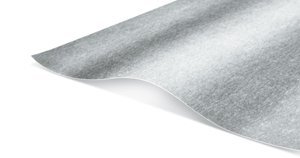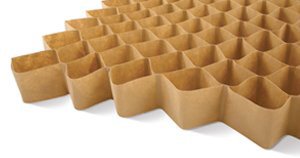- Market Sector
- Application Function
- Products
- Geotextiles
- Civil Geotextiles

Civil Geotextiles
Maintain soil separation and eliminate the mixing of aggregate and sub-base soils. - AASHTO Geotextiles

AASHTO Geotextiles
TYPAR® C-Class construction geotextiles for AASHTO M-288 applications. - Landscape Fabric

Landscape Fabric
TYPAR® Landscape Fabric blocks weeds while letting water and nutrients through.
- Civil Geotextiles
- Geocomposites
- Geocomposite Drains

Geocomposite Drains
TYPAR geocomposite drains are are a highly effective alternative to traditional drainage solutions. - Frost Blanket

Frost Blanket
A purpose-designed, protection geo-composite for mitigating the effects of frost heave. - Salt Barrier

Salt Barrier
Developed to prevent damage caused by the capillary rise of saline groundwater into 'sweet' soil zones.
- Geocomposite Drains
- Geocells
- Geocell - Load Support

TYPAR Geocell - Load Support
TYPAR Geocell GS transfers downward forces, laterally, reducing loads on underlying soils. - Geocell - Slope Protection

TYPAR Geocell - Slope Protection
This system improves resistance to erosive forces on steep, unstable slopes exposed to hydraulic or mechanical depths. - Geocell - Flood Control

TYPAR Geocell - Flood Control
TYPAR GeoCells offer a quicker, easier alternative to sandbags in emergency flood events. - Geocell - Gun Range

TYPAR Geocell - Gun Range
TYPAR GeoCell is the next generation of structures for firing ranges. - Geocell - Erosion and Sediment Control

TYPAR Geooell - Erosion and Sediment Control
TYPAR GeoCell panels provide superior sediment control for stormwater runoff. - Geocell - Mining Containment

TYPAR Geocell - Mining Containment
Secondary confinement for mining operations. - Defencell - Military and Security Geocell

Defencell - Military & Security
DefenCell™ Protective Wall System for military, security and environmental applications.
- Geocell - Load Support
- Ground Reinforcement Mesh
- GrassProtecta grass reinforcement mesh

GrassProtecta
GrassProtecta grass reinforcement mesh reinforces and protects grass surfaces. - TurfProtecta turf reinforcement mesh

Turf Protecta
An extruded plastic grass reinforcement mesh, providing protection for occasional light vehicle or pedestrian use. - GrassCarpet grass protection

GrassCarpet grass protection
Plastic mesh reinforced geotextile for temporary grass reinforcement for access, parking and grass tracks.
- GrassProtecta grass reinforcement mesh
- Porous Paving
- BodPave 85 Porous Pavers

BodPave 85
Plastic porous paving provides reinforced, durable, safe and eco-friendly surface for grass or gravel filled trafficked areas. - TYPAVE 25 Flexible Porous Paving

TYPAVE™ 25 Flexible Porous Paving
Sustainable porous paving solution for reinforcing grass and gravel surfaces for traffic.
- BodPave 85 Porous Pavers
- Pipe Protection / Underground Marking
- Detectamesh

Detectamesh detectable mesh tape
Detectamesh is a colored plastic detectable mesh for marking and detecting buried underground pipes, cables and services. - Wavelay Detectable Tape

Wavelay Detectable Tape
Wavelay™ is a colored plastic detectable tape for marking and detecting buried underground services. - Underground Warning Tape

Underground Warning Tape
Polyethylene underground warning tape with a printed warning message for marking underground buried surfaces. - Protectamesh HD Rockshield Mesh

Protectamesh HD Rockshield Mesh
Protectamesh HD rockshield mesh is a thick, heavy-duty pipeline mesh for protecting pipeline coatings from rock backfills.
- Detectamesh
- Root Barrier
- Geotextiles
- Projects
- Technical Info /
Downloads - About
- Contact
- How to Buy
Battling The Flood In Smithland, Kentucky with TYPAR geocells
Situated at the confluence of the Ohio and Cumberland Rivers, Smithland, Kentucky, a historic town and county seat of Livingston County, is no stranger to fighting floods. While rising spring waters have at times threatened the community, Smithland has never had to deal with floods as dire as what late April and early May 2011 has delivered. With little notice, the community of just over 400 people had to prepare for a record surge in river levels. The Louisville office of the U.S. Army Corp of Engineers contacted Fiberweb® to request the emergency installation of a TYPAR® Geocells / Defencell® Flood Wall system.
Quick, easy and effective TYPAR Geocells are made in the USA and can be used to protect property from flood damage and to meet local codes and state and federal regulations for sediment and erosion control. Depending on the fill, TYPAR Geocells can be used for flood and water control or construction erosion and sediment control. TYPAR Geocells serves the civilian environmental application market.
This project represents the largest ever emergency installation of a Geocell Flood Wall system in the United States. The Geocell Flood Wall is a geotextile-based system, originally developed for ballistic defenses in military operations, and can be quickly constructed utilizing local fill, sand, or other common aggregates.
Within 24
hours of receiving a call from the Corp of Engineers, Fiberweb delivered
three miles worth of Geocell Flood Wall units that, once installed,
would provide almost four feet of additional flood protection height to a
key stretch of the levee in Smithland.
As a testament to the
product’s ease of use, within an hour of delivery to Smithland small
teams were able to start placing, connecting and filling, the Geocell
Flood Wall systems using primarily skid steers. And within the first
three hours, they achieved an installation rate of 20+ units per hour.
At that rate, the teams installed the equivalent protection of
approximately 22,196 sandbags in only the initial three hours after
delivery of the Geocell Flood Wall system
Primary Usage In Smithland
Over
the next 34 workable hours and under the guidance of USACE, the
installation teams were formed from volunteers including local citizens,
city employees, National Guard support, and even inmates from nearby
correctional facilities. The end result being more than 10,500 linear
feet of Geocell Flood Walls had been installed, 700+ units were filled,
stretching over one mile in length—stacked two units high—to help raise
the town levee to meet the pending flood projections.
The
speed of this installation is in stark contrast to traditional
sandbagging operations. In such a short window of time, more than 4,700
tons of sand has been contained in the Geocell Flood Wall system. All
this can be accomplished with the help of a Geocell Flood Wall system
and its flexibility, ability to contour to uneven ground surfaces with
minimal prep work, makes angles and curves, while being light weight and
man portable for ease of placement.
The leadership of the U.S.
Army Corp of Engineers, the outstanding efforts of the community and
volunteers, and cooperative efforts between Fiberweb, Inc. and EMAC, LLC
all helped made this work possible.
Aerial photo supplied by USACE










